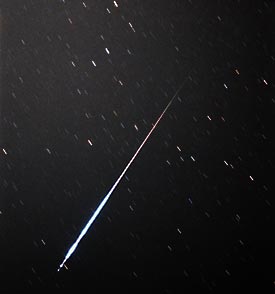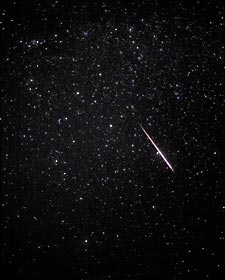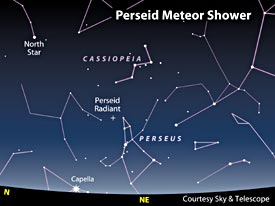August 4, 2005
Contact:
Alan MacRobert, Senior Editor
855-638-5388 x151, [email protected]
Marcy McCreary, VP Mktg. & Business Dev.
855-638-5388 x143, [email protected]
Note to Editors/Producers: This release is accompanied by publication-quality illustrations and broadcast-quality animations; see details below.
The Perseid meteor shower, an annual celestial event beloved by millions of skywatchers around the world, returns to the night sky this coming week.
Sky & Telescope magazine predicts that the Perseid shower will reach its peak late on Thursday and Friday nights, August 11-12 and 12-13 (for viewers in North America). The rate of activity should pick up after midnight until the first light of dawn.
An observer under a dark sky might see more than 60 Perseids per hour between midnight and dawn. The first-quarter Moon sets by about midnight on these dates, so moonlight will not interfere.
You'll need no equipment but your eyes. The darker your sky, the better — any artificial light pollution in your sky will reduce the number of meteors visible. But even if you live in an urban or suburban area, you have a good chance of seeing at least some meteors.
Find a dark spot with a wide-open view of the sky. Bring a reclining lawn chair and a sleeping bag; the bag not only provides warmth against the late-night chill but also serves as mosquito armor in this era of West Nile virus. Cover your remaining exposed parts (including hair and clothing) with an effective mosquito repellent.
"Go out after about 11 or midnight or so, lie back, and gaze up at the stars," says Sky & Telescope senior editor Alan MacRobert. "Relax, be patient, and let your eyes adapt to the dark. With a little luck you'll see a 'shooting star' at least every few minutes on average."
Perseids can appear anywhere and everywhere in the sky. So the best direction to watch is wherever your sky is darkest, probably straight up. Faint Perseids appear as tiny, quick streaks. Occasional brighter ones may sail across the heavens for several seconds and leave a brief train of glowing smoke.
If you trace each meteor's direction of flight backward far enough across the sky, you'll find that this imaginary line crosses a spot in the constellation Perseus, near Cassiopeia. This is the shower's radiant, the perspective point from which all the Perseids would appear to come if you could see them approaching from the far distance. The radiant is low in the north-northeast before midnight and rises higher in the northeast during the early-morning hours.
Don't give up if it's cloudy on the peak nights. The shower lasts for about two weeks, with good rates in the predawn hours of August 10th through 15th. (The radiant is always low or below the horizon for Southern Hemisphere countries like Australia, New Zealand, and South Africa; therefore few if any Perseids can ever be seen from these regions.)
The Perseid meteoroids are tiny, sand- to pea-size bits of rocky debris that were shed long ago by Comet Swift-Tuttle. This comet, like others, is slowly disintegrating as it orbits the Sun. Over the centuries, its crumbly remains have spread all along its 130-year orbit to form a sparse "river of rubble" hundreds of millions of miles long.
Earth's own path around the Sun carries us through this stream of particles every mid-August. The particles, or meteoroids, are traveling 37 miles per second with respect to Earth at the place where we encounter them. So when one of them strikes the upper atmosphere (about 50 to 80 miles up), it creates a quick, white-hot streak of superheated air.
For several years in the early 1990s the Perseids performed spectacularly, flaring with outbursts of up to hundreds of meteors visible per hour. The rubble streams responsible for these outbursts were probably shed during Comet Swift-Tuttle's swing by the Sun in 1862. In recent years, though, the shower has returned to normal.
More about the Perseids and how to watch them — including how to make a scientific meteor count and where to report it — appears in the August 2005 issue of Sky & Telescope magazine and online in the articles listed at the end of this press release.
Sky & Telescope is pleased to make several publication-quality illustrations and broadcast-quality animations available to the news media. Permission is granted for one-time, nonexclusive use in print and broadcast media, as long as appropriate credits (as noted in each caption) are included. Web publication must include a link to SkyandTelescope.com.

A bright Perseid meteor streaks across the sky on August 13, 1985. Most meteors are white, but this one began red and flared to brilliant blue-white during its 1-second-long appearance. Click on the image to download a publication-quality version (8-megabyte TIFF, CMYK) by anonymous FTP.
Photo by Michael Shin; courtesy Sky & Telescope.

A brilliant Perseid flashes across the constellation Andromeda on August 12, 1997, and a fainter meteor flares near the W of Cassiopeia (at top in full frame). Rick Scott and Joe Orman made this 8-minute exposure in Florence Junction, Arizona, using a 21-millimeter f/2 lens and Ektachrome P1600 film. Click on the image to download a full-frame, publication-quality version (30-megabyte TIFF, CMYK) by anonymous FTP.
Photo by Rick Scott and Joe Orman, courtesy Sky & Telescope.

This is a reduced-size frame from Sky & Telescope's broadcast-quality QuickTime animation (TRT 20:03) simulating the appearance of the Perseid meteor shower at 11 p.m. in mid-August. Click on the image to download a publication-quality version (244-kilobyte JPEG) by anonymous FTP, or click on the following link to download the complete animation: 6-megabyte MOV.
Sky & Telescope illustration and animation by Gregg Dinderman.

These are reduced-size frames from Sky & Telescope's broadcast-quality QuickTime animation (TRT 14:24) showing how a meteor is formed when a speck of cometary debris burns up in Earth's upper atmosphere. Click on the image to download the complete animation (17-megabyte MOV) by anonymous FTP.
Sky & Telescope animation by Steven A. Simpson.
Sky Publishing Corp. was founded in 1941 by Charles A. Federer Jr. and Helen Spence Federer, the original editors of Sky & Telescope magazine. The company's headquarters are in Cambridge, Massachusetts, near the Harvard-Smithsonian Center for Astrophysics. In addition to Sky & Telescope and SkyandTelescope.com, the company publishes Night Sky magazine (a bimonthly for beginners with a Web site at NightSkyMag.com), two annuals (Beautiful Universe and SkyWatch), as well as books, star atlases, posters, prints, globes, and other fine astronomy products.
 0
0
Comments
You must be logged in to post a comment.